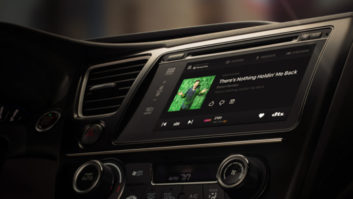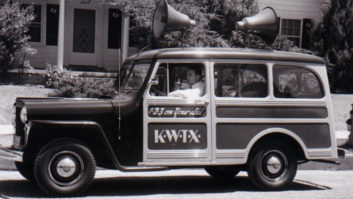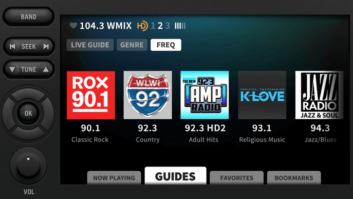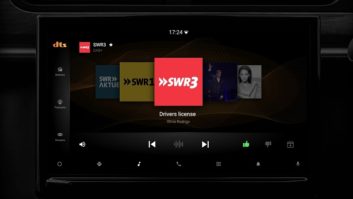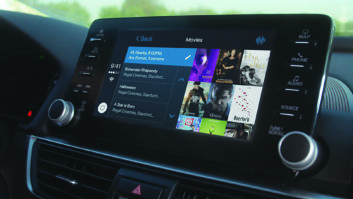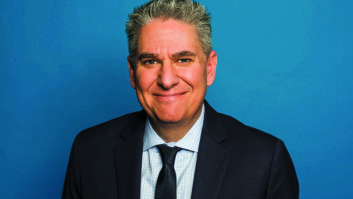Localism is the lifeblood of small-market radio, and nowhere is that more evident than at WIOE, a 100-watt low-power FM located in Warsaw, Ind., a community with a population of 16,000. Although the station is only six years old, it has established a record of innovation and ambition.
WIOE is the brainchild of Brian Walsh, a former radio station owner who does contract engineering work for several area stations.

Brian Walsh and daughter Brianna broadcast from the Taste & Trade Expo. The story begins before the application was filed. An earlier LPFM application by the Warsaw High School was turned down by the Federal Communications Commission. The school had planned on using the facility to train students in its communications program. In 2002, Walsh’s application was granted, making it the fourth LPFM in Indiana.
“When that happened,” he said, “I approached the school and said, ‘Let’s work on this together.'”
Listener choice
The result of the collaboration was an agreement under which studios would be constructed at the high school for student broadcasts.
Currently 68 students (up from 49 last semester) are enrolled in the program, which gives experience in behind-the-scenes aspects of radio broadcasting in addition to on-air exposure. Students are involved in raising underwriting dollars, copywriting, promotions and production, in addition to broadcasts of school sports events and band concerts.
One of the first orders of business was to have the community pick a format. The strength of the response surprised Walsh.
“In the first two weeks we received 571 votes on the Web site,” he said. In the end, an oldies format was selected and ‘Oldies 98.3 FM’ was born. Most of the programming originates from the high school studios. “Only a few of the 68 know the music. It’s the information and opportunity between the music that holds [their] attention. The students say the station is cool.”
Remote broadcasts are a regular part of WIOE’s community outreach. The station uses a refurbished RV that had been custom-built for WOWO(AM/FM) in nearby Ft. Wayne. The van can be seen at county fairs, sports events and trade shows. The station also works with the Salvation Army, Toys for Tots and other not-for-profit organizations to provide exposure for their events.

Gregg Reed works remote broadcasts and is one of the original WIOE air personalities. 24/7
Likely to generate more notice, though, is the station’s helicopter.
It actually belongs to Walsh. He has been flying since 1987 and now has the chopper “decaled up with Oldies 98.3 FM to the hilt” to help attract crowds at remotes and other events. He also uses it for fundraising; for instance after the Warsaw Home Show this year he made several flights to take property owners up to take pictures of their farms and homes; in turn they make contributions to WIOE. He says the chopper “also makes getting to a radio station in need of engineering help quick and convenient.”
Another promotion gives a listener the opportunity to do his or her own two-hour radio show. The RV is driven to the winner’s house. That promotion has been done twice and is well received.
Walsh says proudly that WIOE was the only area radio station to broadcast former President Bill Clinton’s speech at the high school last year while he was campaigning for Hillary Clinton, as well as President Obama’s news conference in Elkhart this February.
WIOE recently began broadcasting its first live church service. Both video and audio are employed. The video is streamed live to WIOE for distribution via the Internet on the www.wioe.com site. The audio is microwaved via RPU to the studios. Both video and audio archives of the services are available on both the station and church sites.
Many church members have expressed appreciation for the broadcasts, as they live out of state or in area nursing homes, Walsh said.
WIOE is staffed 24 hours a day, with overnight hours filled by community volunteers. Walsh said there is never a problem finding people to fill these shifts, or do other work for the station.
“Everyone who works here has a lot of fun, and once they come on board, they just don’t want to leave.” Additionally, all seven members of the board of directors have radio experience. Walsh handles the engineering duties.
The 24/7 human presence means that the station is regularly called by the county sheriff’s office and other organizations that need to get announcements on the air quickly. The station also is used by the school board to air announcements about schedule delays or breakdowns of school buses.
The station has a relationship with the local newspaper, The Times Union, for news content. Reporter Gary Gerald records a 90-second afternoon newscast for Oldies 98.3 FM that is aired weekday afternoons. The segment is produced by students.
Though his family provided the initial startup capital, Walsh said most funding for WIOE now is provided by two local orthopedic companies, two foundations and the Warsaw Community Schools. The Web has also become a good revenue stream: “In 2008 all of the away sports broadcast phone lines were paid for from the sponsors on the Oldies 98.3FM Web site.”
More to come
Brian Walsh Born in Germany, Brian Walsh, the driving force behind WIOE, was raised mostly on a farm 20 minutes south of Warsaw, Ind.
His first radio job was on the air at WAYT(AM), now WJOT, in Wabash in 1983; he also did engineering work there. An early mentor was Dave Walrod at WSAL(AM/FM) in Logansport.
After college Walsh worked at WOWO(AM/FM) in Fort Wayne (“10 great years”).
He has built several radio stations as well as a family; he and his wife Renne’ have five daughters. This LPFM also has a clear goal for digital radio: It hopes to establish an HD2 FM Hispanic station.
“Warsaw has a large Hispanic population. The board wants to communicate more effectively to that segment of our community,” Walsh told Radio World.
“WIOE is established well within the community and we don’t want to disrupt that. To get listeners to purchase HD Radios the programming has to be compelling. I believe offering a 24/7 Hispanic-programmed channel originating … will be unique; and the only place parents can hear those students will be on WIOE(LP), HD2.”
There’s no exact timeline for the project yet. “We continue to negotiate with iBiquity on fees,” he said. But the equipment details have been worked out; and as part of the project, the station’s aux tower will become the main transmitter site to save on STL expenses. WIOE recently was granted a construction permit for the auxiliary transmitter site at its studio; Walsh has been told by FCC officials that the station is one of only a couple of LPFMs to have such facilities.
Making HD Radio work on LPFM poses some challenges because of a lack of out-of-the-box solutions at this power level.
“We have developed a partnership with Nautel and Crown,” said Walsh, “where the two companies will combine the Nautel HD exciter and Crown LA75 amplifier.” The system will deliver a 100-watt analog carrier along with a 10-watt HD signal. The station has applied for an STA to use 10 watts instead of the customary 1 watt for which a 100-watt LPFM would normally be licensed.
Walsh plans to build another studio at the school to support the Hispanic programming.
He also believes that there is ample programming material for additional HD Radio channels in most markets. “Do some research, and find out who filed unsuccessful applications with the commission in the last filing window, get in touch with them and make a deal.”
Feeling that using RDS for artist/song title information with an oldies format might not be the best utilization of resources, Walsh instead turned it into a revenue stream.
“We have eight sponsors who pay $25 a month, and underwrite weather forecasts, information on school closings and other local news.”
WIOE is also trying to be a “green” LPFM. A 2 kW wind turbine mounted on a 40-foot pole above the transmitter building connects to four 200A/h batteries, which drive an inverter. The system starts producing power with a 5 mph wind, and generates 13 to 1,500 watts in the steady 10–13 mph wind common in the area. This is more than enough juice to power the station’s Broadcast Electronics FX-50 exciter/transmitter and related equipment. “Our last electric bill was around $12,” said Walsh. At press time, the turbine was idle in anticipation of being moved to the new transmitter site.
Another green initiative is heating the transmitter building with a special furnace that runs on used motor oil, which is donated to the station, so heating costs essentially are free.





